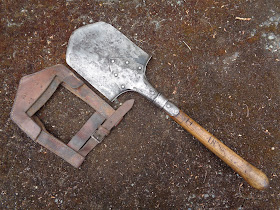I have an old Austro-Hungarian shovel that has been in the collection for some time, without a cover. I originally purchased it, sight unseen, as a Hungarian Army entrenching tool. When it arrived, it was pretty obvious that it was a WW1 era, Austro-Hungarian shovel that had continued its service with the Hungarian Army, well into the Cold War. I have been on the lookout for a good cover ever since.
You can read about that Austro-Hungarian shovel on my blog post here:
https://sharky-fourbees.blogspot.com/2015/10/austro-hungarian-ww1-trench-spade-model.html
There have been quite a number of the old, leather, Austro-Hungarian shovel covers coming out of Bulgaria lately. After WW1, Bulgaria continued using the old Austro-Hungarian shovels, through WW2, and into the Cold war era. The Bulgarians "modernized" the old covers by removing the belt loops and restitching them lower on the cover. I believe my cover most likely came out of Bulgaria, since it has the signature "Bulgarian belt loops". The Austrian covers that were used in WW1, used a single belt hanger that was attached at the point-top of the cover.
From what I understand, the Bulgarian covers were nearly all made in Germany and Austria under contract for the Bulgarians, and many of the covers have manufacturer's stamps from German companies.
There is not much more I can say about my cover, other than it is a M-1910 style, cover. It fits the old WW1 Austro-Hungarian shovel quite nicely, and looks great!
The cover has a couple of small markings stamped into it. "T.D. II", and an "A". See the update below for the full meaning of the T.D. II amrking
UPDATE 7-7-20: I received some information from some other historians, reference the T.D. II stamped markings. One collector stated that the Austro-Hungarian Army used the T.D. stamp to designate units of the "Traindivision". He stated that the T.D. stamps can be found on firearms and other equipment that were issued to the "Traindivision" troops. The "Traindivision" troops were supply troops. A bit of research revealed that one of the T.D. units that was activated and serving with the Austro Hungarian Army in 1914, was the Traindivision Nr.II. This was the Supply Troop of the 2 Corps. The "II" could also be a double one, "11", but that is a bit unlikely. The more obvious and likely option is that the "II" is actually the roman numeral for "2". This fits the stamping perfectly! T.D. 2 was garrisoned in Wien, also know as Vienna, Austria. The "A" stamp is still under investigation.
I also was informed that the Bulgarians received all of their shovels and shovel covers from Germany during WW1. At this time, Bulgaria was allied with Germany. The Bulgarian shovels were the same type as the Austrian shovels.
A second collector and historian, said that the T.D. II markings were placed on items that were constructed at the German, Traindivision II, military workshop. Since Germany supplied the leather covers to Bulgaria during WW1, it is safe to say that my cover was constructed by the Germans at their Traindivision II military workshop and then sent to Bulgaria, under contract.
If the "II" stamping is actually the roman numeral for "2", as opposed to "11", then it was for the Traindivision Nr.2, that was garrisoned in Vienna Austria. You can see how it is very tough to positively identify units from markings! Another complication is that both Germany and the Austro-Hungarian Empire used similar, or identical, markings. Without extra information that traces an item back to a specific location or military unit, it often comes down to writing the most likely narrative about the history of an item based on the clues.
Here is a wonderful website that has a very complete list of the Austro-Hungarian units during WW1. Great information, and the best I've found when it comes to deciphering unit numbers!
http://www.austro-hungarian-army.co.uk/orb14.htm
Now let's take a closer look at this cover.














Здравствуйте.
ReplyDeleteЭто лопата произведена не Австро-Венгрии, а в Венгрии, период между 1 и 2 мировыми войнами
Что касается чехла - то здесь Вы правы
С уважением, Николай (Россия)